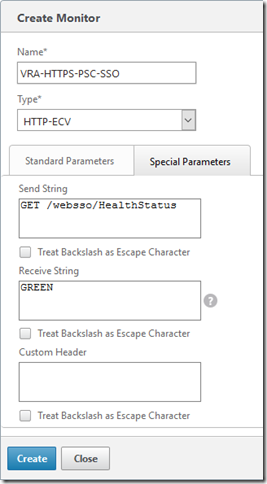Load Balancer
 Written by Sam McGeown
on 19/8/2015
Written by Sam McGeown
on 19/8/2015![]()
Enter a name for the monitor, and leave the other parameters the same. Select the “Special Parameters” tab and configure the send string to the URL to monitor - e.g for the PSC SSO it’s going to be:
For the receive string, enter the expected response (“GREEN”). Click Create.

Assigning a NetScaler Monitor to a Service
Assign the monitor to the PSC Services (or Service Groups) configured for PSC by opening the Configuration > Traffic Management > Load Balancing > Services page and selecting the PSC service for HTTPS/443 and clicking Edit.
 Written by Sam McGeown
on 8/7/2015
Written by Sam McGeown
on 8/7/2015The recommendations for the vRealize Appliance have changed with 6.2, the published reference architecture now does not recommend using an external Postgres database (either vPostgres appliance, a 3rd party Postgres deployment or using a third vRealize Appliance as a stand-alone database installation). Instead the recommended layout is shown in the diagram below. One instance of postgres on the primary node becomes an active instance, replicating to the second node which is passive. In front of these a load balancer or DNS entry points to the active node only. Fail-over is still a manual task, but it does provide better protection than a single instance.
 Written by Sam McGeown
on 7/7/2015
Written by Sam McGeown
on 7/7/2015Providing a highly available single sign on for vRealize Automation is a fundamental part of ensuring the availability of the platform. Traditionally, (vCAC) vRA uses the Identity Appliance and relies on vSphere HA to provide the availability of the SSO platform, but in a fully distributed HA environment that’s not really good enough. It’s also possible to use the vSphere 5.5 SSO install in a HA configuration - however, many companies are making the move to the latest version of vSphere and don’t necessarily want to maintain a 5.5 HA SSO instance.
 Written by Sam McGeown
on 11/2/2015
Written by Sam McGeown
on 11/2/2015vRealize Log Insight 2.5 improves on the clustering in previous versions with an Integrated Load Balancer (ILB) which allows you to distribute load across your cluster of Log Insight instances without actually needing an external load balancer. The advantage of this over an external load balancer is that the source IP is maintained which allows for easier analysis.
The minimum number of nodes in a cluster is three, the first node becomes the Master node and the other two become Worker nodes. The maximum number of nodes supported is six, though acording to Mr Log Insight himself,
 Written by Sam McGeown
on 18/9/2014
Written by Sam McGeown
on 18/9/2014With the release of vCAC 6.1 there have been some great improvements in the setup of the clustered vCAC appliances - none of the previous copying of configuration files between appliances - just a simple wizard to do it all for you. In my opinion this is superb.
You’ll need to have deployed a load balancer of some sort -
 Written by Sam McGeown
on 25/6/2014
Written by Sam McGeown
on 25/6/2014This is the second part of the 3rd article in a series about how to build-out a simple vCAC 6 installation to a distributed model.
By the end of this part, we will not have modified the vCAC deployment in any way, we’ll just have 3 configured load balanced URLs
An overview of the steps required are below:
 Written by Sam McGeown
on 25/6/2014
Written by Sam McGeown
on 25/6/2014This is the first part of the 3rd article in a series about how to build-out a simple vCAC 6 installation to a distributed model.
By the end of this part, we will not have modified the vCAC deployment in any way, we’ll just have 3 configured load balanced URLs
An overview of the steps required are below:
